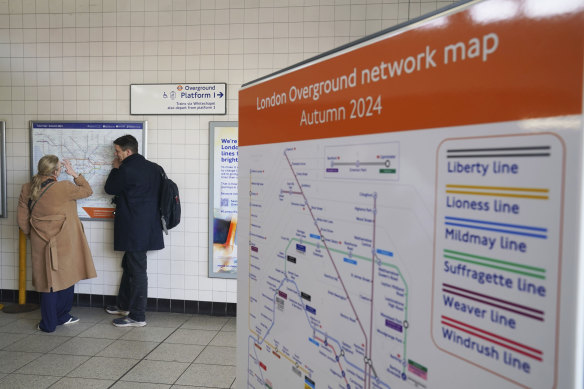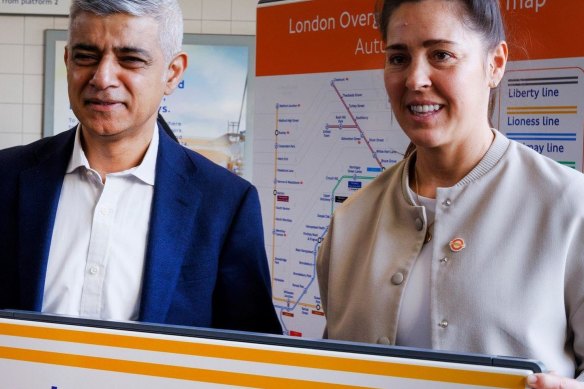
Critics have, however, branded the move “virtue signalling”, “patronising” and a “pointless gimmick”.
Professor Jeremy Black, a historian at the University of Exeter, accused Khan of politicising the railways.
“Khan is politicising history in a way that is undesirable,” he told London’s The Daily Telegraph. “Why call a railway line Windrush? The Empire Windrush was a ship. It’s bonkers.”

A sign for the new Windrush line.Credit: AP
Transport for London (TfL) said it had worked with customers, stakeholders, historians, industry experts and local communities, with the names representing the areas the lines travel through while marking London’s history and cultural diversity. But it appears it came as a surprise to Londoners, with many feeling the names had been sprung upon them with no consultation.
The Tube map, created by Harry Beck in 1933, has become a London and global icon with a simple and easy design. But research by TfL established that some customers found the Overground network confusing. They said it would be easier to navigate if it wasn’t a single colour and name.
Loading
The announcement was significant enough to warrant an editorial in The Times, which said that in seeking to be inclusive, the new names risk excluding communities not honoured.
“The Windrush, for instance, while partially compensating for the Home Office’s scandalous treatment of many mid-20th century West Indian immigrants, may leave those with family origins in India, Pakistan and Bangladesh wondering where their tribute is. And what of the Irish, whose labour built much of the UK’s transport infrastructure in the first place?”
Since coming under Transport for London’s control in 2007, the Overground has become the second-busiest railway in the country with about 180 million passengers a year. Only the newly built Elizabeth line, with about 220 million a year, is busier.
The Euston to Watford Junction part of the Overground, which calls at Wembley Central Station, will be renamed the Lioness line in honour of the England women’s football team that won the Euros at the ground in 2022.

One of the new lines will be named after the England women’s football team.Credit: Instagram
Loading
The Windrush line runs through several areas with strong ties to Caribbean communities, including Dalston Junction and West Croydon, in honour of the Windrush community. The Weaver line – with stops around Liverpool Street, Spitalfields and Hackney – travels through several areas of London known for their importance in the textile trade.
Named to celebrate London’s East End working-class community’s fight for women’s rights, the Suffragette line will run to Barking, home of the longest-surviving suffragette, Annie Huggett, who died aged 103.
Michael Roberts, chief executive of the capital’s transport watchdog, London TravelWatch, said: “Distinguishing between the separate lines should help passengers plan journeys more easily and know which services are running at times of disruption simply by hearing the name of the line.”
Get a note directly from our foreign correspondents on what’s making headlines around the world. Sign up for the weekly What in the World newsletter here.









 Add Category
Add Category